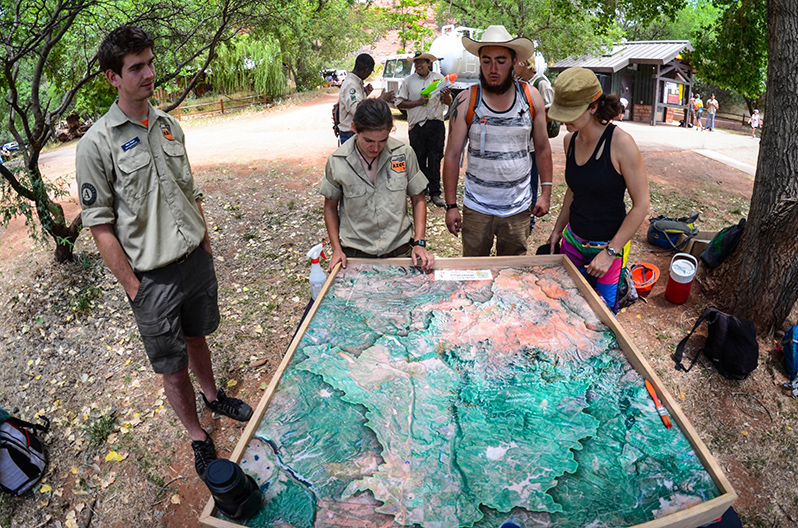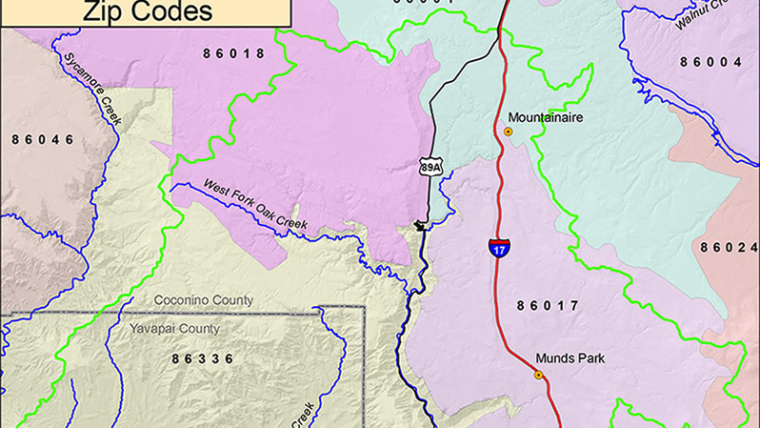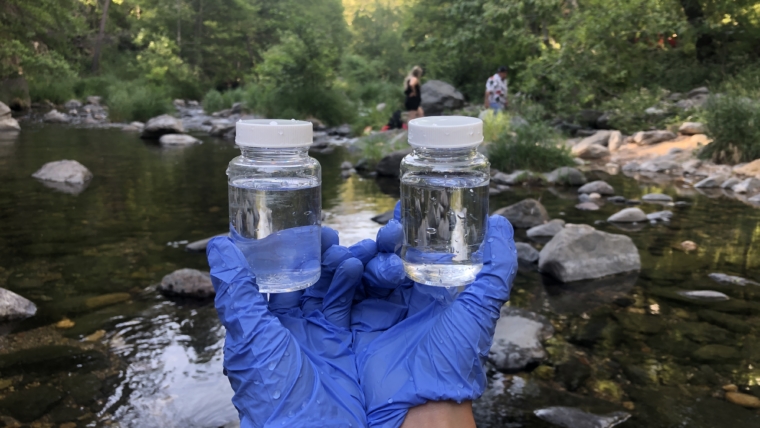June 27, 2012
PDF of this article HERE
The Oak Creek Watershed, that is. Fifty miles of fresh water perpetually in motion, Oak Creek is the thread that weaves together the fabric of our watershed community, as well as being vital to its economic, recreational and natural future.
Some think that the movement of water represents life itself, and has soothing, relaxing properties. That would definitely be a fitting description for Oak Creek most of the time, but on other occasions, it is one independent critter, thrashing and swirling; hurling everything in its way with wild abandon; an untamed beast with awesome power.
We all love it, though, right? Angry or calm, it’s there every day for us to enjoy. We fish it; swim in it; drink it; photograph it; gaze at it; encourage others to visit and enjoy it, too. A multi-faceted playground set against a backdrop of pine forests and red rocks down to a valley of undulating terrain, grasslands and floodplain.
Oak Creek meanders from its head waters in Fry Canyon through Coconino County, the City of Sedona, and Yavapai County to its confluence with the Verde River, joined by five major limb-like tributaries on its trek–Pumphouse Wash, West Fork, Munds Canyon, Dry Creek and Spring Creek.
What is a watershed anyway? According to the Environmental Protection Agency (EPA), a watershed is the area of land where all the water that is under it, or drains off of it, goes into the same place. In our watershed, of course, that “same place” is Oak Creek.
Watersheds come in all shapes and sizes. They cross county, state, and national boundaries, and there’s over 2100 of them in the continental U.S.
Our own Oak Creek Watershed is part of the Verde River Watershed, and is approximately 300,000 acres, or about 464 square miles, and Oak Creek arises from a series of springs.
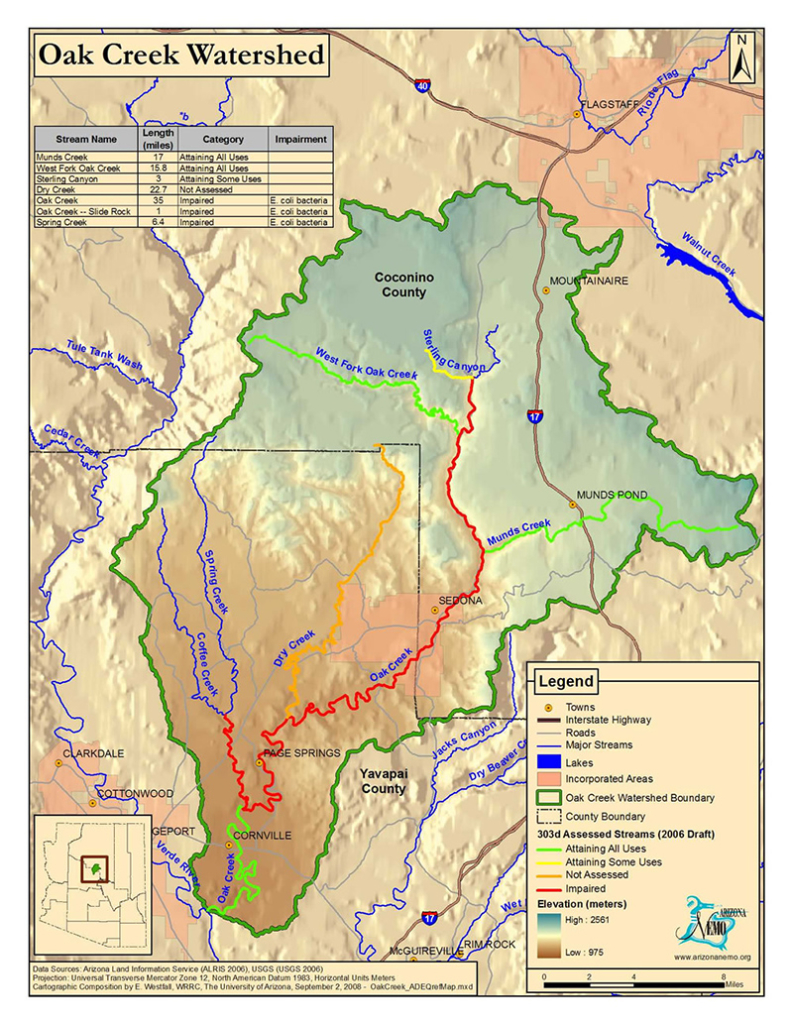
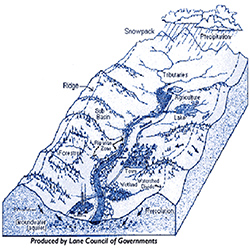
Springs? So how does the water magically appear? Ten years ago, Dr. Gordon Southam, a geomicrobiologist, authored a source mapping study of Oak Creek along with other staff and personnel from Northern Arizona University (NAU), in which is stated that “water recharging from the Mogollon (muggy-own) Rim percolates through the Coconino Sandstone and fractures along the Oak Creek fault, feeding the upper reaches of Oak Creek. The regional aquifer is composed of the Verde Formation, Coconino Sandstone, Supai Formation, Redwall Limestone, Martin Formation and Tepeats Sandstone.
Regional groundwater flow is to the southwest, with the exception of a small region of north and northeasterly flow above the Rim. Groundwater depths range from 200 to 500 feet below land surface. Seeps and springs feed the alluvium along the Creek, supplementing baseflow from the regional aquifer. The portion of the watershed below the Rim experiences little or no recharge since in most months evaporation exceeds precipitation. However, during the winter months there may be some recharge since precipitation exceeds evaporation.”
The pristine birthplace of Oak Creek would seem to be the perfect ending to its beginning, but alas, it is also the beginning of its troubles. While Oak Creek is classified by ADEQ as an “outstanding” watercourse, it’s also on the “non-attaining” list due to persistence of the indicator fecal coliform bacteria Escherichia coli (E. coli) suggesting fecal contamination. It’s a persistent problem that results in periodic closures of recreational areas and can cause recreation water illnesses. The persistence of E. coli in the watershed may indicate various sources including recreational users as well as domestic and wild animals.
The state and federal governments have spent a lot of money over the past twenty years trying to identify and eliminate sources of fecal contamination to Oak Creek.
Now, they’ve basically said “enough is enough” and in October, 2009, ADEQ awarded the Oak Creek Watershed Council a Water Quality Improvement grant, under the federal Clean Water Act, to develop the Oak Creek Watershed Improvement Plan (OCWIP) that will identify where contamination problems are occurring along the entire length of Oak Creek, and offer solutions to be implemented. The Plan will be completed by Aug 31st, 2012, and some solutions in Phase II also implemented in 2012, however, large-scale and/or multiple mitigation efforts are expected to be accomplished in 2013, and beyond. In a nutshell, the challenge faced by the OCWC is to find, fix, finish, and follow-up the problems associated with the impairment of Oak Creek.
While the Oak Creek Watershed Council is providing the management expertise, this is a community-driven project, and decisions made on the “find, fix, and finish” aspects are a shared responsibility by a group of citizens called the Watershed Improvement Commission (WIC).
The OCWIP project is based on a scientific approach and designed to identify and reduce, if not eliminate, fecal contamination, but the OCWC recognizes that without the continuing involvement, and understanding, by the watershed community on an on-going basis, permanently removing Oak Creek from the non-attaining list will be an overwhelming challenge. That’s where the “follow-up” kicks in, and while the OCWC is committed to preserving the integrity of Oak Creek, it is essential that its stewardship must be a part of the watershed community culture.
To this end, the OCWC is in the process of developing the Oak Creek Community Outreach Program (OCCOP) that will essentially be a community-driven (maintenance) program to remove trash and litter from Oak Creek, as well as educate watershed residents, and visitors, in the proper stewardship of Oak Creek so as to raise the bar on outdoor ethics practiced (or not).
In short, the goal of the OCCOP will be to educate residents and visitors to Oak Creek in following protocols that are expected of them in its use, while at the same time mobilizing a “boots-on-the-ground” volunteer task force to participate in a litter and trash pick-up program, which will eventually may involve the entire length of Oak Creek. It is common for used diapers, as well as animal and human feces, to be found in and around many areas of Oak Creek. Litter and trash, as well as left-over food and refreshments, are also routinely observed, and attract forest animals such as skunks and raccoons that add to the fecal contamination.
The OCWC envisions the future administration of the cleanup program will be similar to an Adopt-A-Highway litter pickup, only referred to as Adopt-A-Creek, and follow the guidelines set out in the National River Cleanup program. On June 23, 2012 OCWC partnered with individual volunteers; other community group volunteers; as well as some who graduated from its Master Watershed Steward Program last year, in order to field about 20 volunteers who collected a dozen bags of litter and trash weighing over 200 lbs from three test areas of Oak Creek including Mormon Crossing, Chavez Crossing and Midgley Bridge up to Grasshopper Point. The Chavez team is shown to the left.
The manufacture of the Oak Creek Watershed Terrain Model is also part of the OCCOP and will be used by the OCWC for educational, outreach and planning purposes. The portable, fiberglass model will be approximately 3’ x 4’ and allow water to be spilled from the top of Oak Creek Canyon, trickling down into Oak Creek, then eventually spilling into the Verde River. The model is expected to be completed by Howard Models towards the end of Aug. 2012. [The model was completed and first displayed in March 2013. News Release HERE; photo at a Terrain Model event is the lead photo above]
In the not too distant future, there will be two choices each member of the Watershed community will face in trying to save Oak Creek. Leave it up to others… or… get involved and ensure the legacy of a pristine and trouble-free Oak Creek for our children’s children.
The former is understandable and at the very least only requires acknowledgment of the problems; support of the solutions; and to give Oak Creek the respect it needs.
If a person believes that Oak Creek is vital to our community’s economic, recreational and natural future, the latter choice is a no-brainer, and participation in whatever form will always be welcome.
Regardless, the end will justify the means, and improve the quality of life for those who live within the watershed. Perhaps, in these troubled times, a united community might even inspire other communities in our country, and prove that together, we ARE making a difference.
Barry Allan
Executive Director

